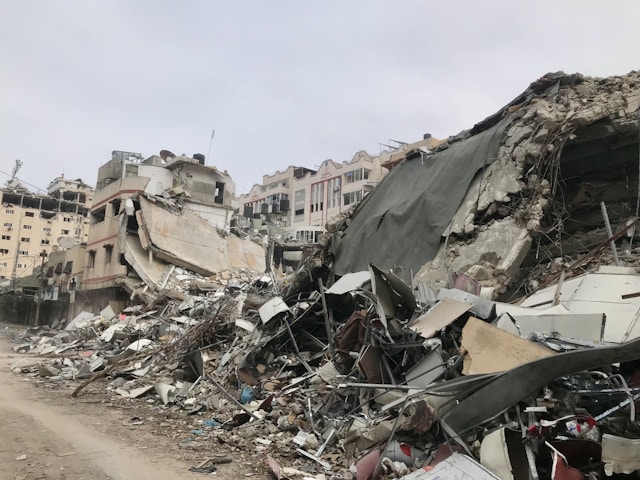Attacks on a school sheltering displaced people and a designated humanitarian zone raise alarm as ceasefire talks stall again
In a devastating escalation of violence, Israeli airstrikes across the Gaza Strip resulted in the deaths of at least 60 people, according to health officials. This wave of attacks targeted a school sheltering displaced individuals and another site that Israel had designated as a “humanitarian zone.” The strikes come as ceasefire negotiations in the ongoing conflict, which has persisted for nearly ten months, appear to have collapsed once more.
On July 16, the Red Crescent reported that 17 individuals lost their lives in a bombing near a petrol station in Mawasi, a coastal area heavily populated with displaced families. Despite being labelled an evacuation zone by Israel, the strike devastated the community. Additionally, another 16 people were killed when the UN-run al-Awda school in Nuseirat refugee camp was targeted. Medics confirmed that Hamas militants were allegedly present at the school, a claim the Israeli Defense Forces (IDF) cited in their justification for the attack.
Embed from Getty ImagesThe IDF stated that airstrikes hit around 40 targets throughout Gaza, which included military posts and structures rigged with explosives. Amid this intense bombardment, the armed wings of Hamas and Palestinian Islamic Jihad launched attacks on Israeli positions, using anti-tank rockets and mortars. Despite their efforts, reports indicate that no damage or casualties occurred on the Israeli side from these retaliatory strikes.
This surge in violence follows one of the deadliest attacks in recent memory, which targeted Mohammed Deif, Hamas’s military commander. The bombing in Mawasi resulted in over 90 deaths, leaving uncertainty about Deif’s fate. According to IDF reports, they claim to have eliminated around half of Hamas’s leadership and over 14,000 fighters since the onset of the conflict, triggered by a deadly assault on Israel in October.
The humanitarian crisis continues to worsen in Gaza, where the health ministry reports that over 38,400 Palestinians have died since the conflict escalated. The territory, home to 2.3 million people, faces severe shortages of food, water, and medical supplies.
As ceasefire negotiations stalled, Hamas sent mixed signals about its willingness to participate further. The group’s political leader, Ismail Haniyeh, indicated a withdrawal from indirect talks in response to recent attacks, yet expressed a readiness to return if Israel showed commitment to reaching a ceasefire and a prisoner exchange.
Despite these setbacks, Israeli Defense Minister Yoav Gallant conveyed optimism to families of kidnapped soldiers, suggesting that a deal may be closer than ever. However, ongoing disagreements regarding hostages and prisoners have consistently undermined truce efforts.
The situation remains fluid as both sides grapple with the complexities of conflict and negotiation. With the international community watching closely, the path to peace appears fraught with challenges, underscoring the urgent need for dialogue and resolution.
Analysis:
Political:
The latest Israeli airstrikes represent a critical juncture in the ongoing conflict, highlighting the complexities surrounding military action and diplomatic negotiations. The Israeli government faces immense pressure to demonstrate decisive action against Hamas, especially in the wake of the group’s deadly attack in October. This pressure complicates efforts to reach a ceasefire, as military operations often take precedence over dialogue.
Social:
These events reflect a deepening societal divide within both Israel and Palestine. The repeated loss of civilian lives in Gaza has ignited outrage and protests globally, prompting calls for accountability and humanitarian considerations. The airstrikes and their aftermath further amplify debates about the moral implications of military action in densely populated civilian areas.
Racial:
The airstrikes underscore the racial and ethnic dimensions of the conflict. Palestinian casualties disproportionately affect the already marginalized population, leading to accusations of systemic discrimination and violence against civilians. This dynamic complicates the narrative surrounding Israel’s military objectives and the humanitarian impact on the ground.
Gender:
Gender considerations play a significant role in the ongoing crisis, as women and children often bear the brunt of conflict. The airstrikes disproportionately affect vulnerable populations, raising concerns about gendered impacts and the need for policies that prioritize women’s rights and safety amid violence.
Economic:
The economic ramifications of the conflict are profound. The blockade and ongoing military operations have devastated Gaza’s economy, leaving its residents in dire need of basic necessities. The destruction of infrastructure not only hampers immediate relief efforts but also complicates long-term recovery and stability, indicating that the cycle of violence is closely intertwined with economic despair.
